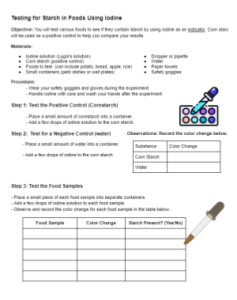
Most biology textbooks have a chapter on macromolecules. In chapter 2 of our textbook, students learn about the chemistry of life, which includes the basics of atoms and molecules, properties of water, and carbon compounds. I generally include a food testing lab where students determine the macromolecules found in food. The lesson is engaging, informative, and a lot of fun for everyone involved. It is also a cheap lab, that doesn’t require a lot of materials.
For my AP Biology class, they complete several tests on a blended up “Happy Meal.” The McMush lab is a gross (and popular) activity for my older students, but is quite messy. Though, it is a little much for a freshman biology class that is just getting started with laboratory techniques.
With freshman biology, I simplify this lab into a single test for starches. This is an easy test, where you will only need iodine. Then you provide students with samples to test in well plates, or other containers. Samples can include apples, rice, potatoes, or other common grocery items. If starch is present, the color of the sample with turn dark blue. If no starch is present, the color will remain a yellow-brown.
For many classes, this may be the first lab students complete. It is also a great way to introduce the concept of indicators, which students will see again in a diffusion lab later in the semester.
The Experiment
You can use well plates, petri dishes, or other containers for testing. Basically, whatever you have laying around will probably work. Begin with a short discussion on indicators and a negative and positive control test. Students place a corn starch solution into the container and place a drop of iodine. They should see a dramatic color change, which is the positive test. Then, they compare to a drop placed in plain water, which is the negative test.
Provide students with a variety of foods to test. The handout leaves the data table blank, so students will need to write in the names of foods they are testing. I use apples, bread, rice, potato flakes, milk, and anything else I can find that’s about to expire in the staff refrigerator. Students will get a positive test on anything with starch, like the potato flakes and bread.
In the final part of the lab, students design and conduct an experiment to determine if protein is present in egg whites. This section is open-ended, and students will use what they have learned in the first part to conduct their test using biuret solution, another indicator.
Related Activities
McMush Lab – testing for macromolecules in a Happy Meal
Diffusion Lab – Observing iodine diffuse across a membrane (bag)
Presentation Slides on the Chemistry of Life with student notes

